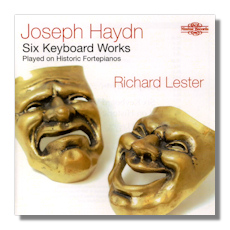
The Internet's Premier Classical Music Source
Related Links
- F.J. Haydn Reviews
- Latest Reviews
- More Reviews
-
By Composer
-
Collections
DVD & Blu-ray
Books
Concert Reviews
Articles/Interviews
Software
Audio
Search Amazon
Recommended Links
Site News
 CD Review
CD Review
Franz Joseph Haydn

Keyboard Works Played on Historic Fortepianos
- Sonata in D Major, Hob.XVI:37
- Sonata in G Major, Hob.XVI:27
- Sonata in C Major, Hob.XVI:35
- Sonata in F Major, Hob.XVI:23
- Partita in E Flat Major, Hob.XVI:Es3
- Divertimento in A Flat Major, Hob.XVI:46
Richard Lester, fortepiano
Nimbus NI5847 74m DDD
One advantage of having so much attention paid this year to the anniversaries of four composers (Purcell, Handel, Haydn, Mendelssohn) whose dates overlap (from 1659 to 1847, they share a total of 37 years) is that we can examine changes in musical style over those almost two centuries. Richard Lester's latest recording of half a dozen keyboard works by the third of these four composers, chronologically celebrates music written at a time of major transition: from the Baroque harpsichord to the Classical fortepiano.
Without this development, usually associated with the galant style, it's hard to see how Mozart, then Beethoven, and after them the entire Romantic movement, could have infused their composition with the feeling and style which they did. Already in the mid eighteenth century composers like C.P.E. Bach and Domenico Scarlatti were exploring the elegance that so permeated the Enlightenment. And even J.S. Bach was aware of and beginning to exploit certain melodic, rhythmic and harmonic attributes of the galant.
Lester argues that such indicators as the presence of dynamic markings in the pieces performed here suggests that Haydn intended them to be played on the fortepiano, rather than the harpsichord – despite the fact that he had both instruments at his disposal, although we have no inventory of exactly what was at Esterházy, the composer's location at the time of their composition. Lester has chosen a Schantz (a make with which we do know Haydn was familiar) for the first four Sonatas (in D, G, C and F, tr.s 1-12). It is thought to have been built in 1795 and is one of only four surviving examples and housed in Bath in the United Kingdom. The other two pieces (in E Flat Major and A-flat Major, tr.s 13-17) are played on a fortepiano of unknown origin restored by Michael Cole.
In keeping with the implicit brief which Lester has set himself for this recording, the qualities of elegance, self-confidence, wry humor and technical (compositional) exuberance, often disguised by apparent simplicity or even ingenuousness, are all evident – and wholly inspiring. Lester has a very deliberate and unambivalent style of playing. Neither dogmatic nor imposing; but supremely confident and full of vigor. These pieces are ideally suited to this approach… listen to the opening movement of the well-known D Major Sonata [tr.1], for example. Although there is always time for sensitivity, it is a sensitivity that comes from Haydn's self-assured presence. From the knowledge that he was communicating, not ruminating. As Lester's playing proceeds through the other two movements (the adagio is played with great understanding), the decisiveness which at the outset was, perhaps, slightly arresting emerges as more than confidence – as the clean and unhesitating presentation of appealing and clear musical ideas for their own sake.
This tone and approach to Haydn's many techniques and turns is maintained throughout the recital. As if Lester wants us to come away feeling we have really learnt something about how Haydn saw the world. A world which flourished as much through clarity and transparency as through emotion – although both were present, to be sure. In that sense, Lester is shining a pre-Classical (a galant, in fact) light on the colors with which Haydn worked. In the pianist's balance between lightness of touch and carefully-articulated changes in tempi, for example, he also seems to be purposefully leaving open to question the extent to which Haydn (unlike most of the generations before him) believed his music was being written for his posterity as much as for his own age. At the same time, Lester's obvious familiarity with and fondness for the music (movements follow one another with pauses that suggest complete engagement, for example) suggest that he is in little doubt about the enduring quality of what Haydn wrote; and how surely it ought to last in our memories, despite the fact that we don't know the occasions for which it may have been written.
The sound on the CD is a pleasing one; the profile of each instrument has been respected in a close and nicely-resonant acoustic. There is a sense in which you are made to feel you are in the room with Lester (or Haydn!) and are hearing the music, if not for the first time, then hearing its nuances and subtleties afresh. This is quite an achievement. Recordings of these Sonatas abound – in their dozens. But far fewer on either the harpsichord, or fortepiano. This – together with Lester's interpretative strengths – makes this a CD to consider very seriously. There is a concise and informative booklet to go with the hour and a quarter's music that straddles well the divide between refinement and untrammeled communication. A valuable contribution to the celebrations of the 200th year since Haydn's death. But a fine addition to the Haydn discography at any time.
Copyright © 2009, Mark Sealey




















